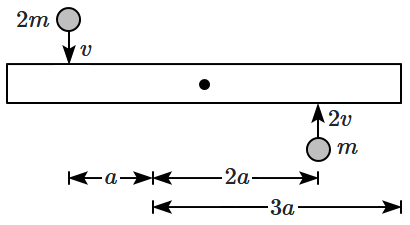A uniform thin rod is bent in the form of closed loop ABCDEFA as shown in the figure. The ratio of inertia of the loop about
x-axis to that about y-axis is:

1. >1
2. <1
3. =1
4. =1/2
x-axis to that about y-axis is:

Four spheres of diameter 2a and mass M are placed with their centres on the four corners of a square of side b. Then the moment of inertia of the system about an axis about one of the sides of the square is
1.
2.
3.
4.
A body of mass m slides down an incline and reaches the bottom with a velocity v. If the same mass were in the form of a ring which rolls down this incline, the velocity of the ring at bottom would have been
1. v
2.
3.
4.


1. \(\frac{3g}{2L}\)
2. \(\frac{3g}{\sqrt{2}L}\)
3. \(\frac{3g}{2\sqrt{2}L}\)
4. \(\frac{6g}{\sqrt{2}L}\)
The moment of inertia of pulley is I and its radius is R. The string doesn't slips on the pulley, as system is released, the acceleration of the system is
 \(\)
\(\)
1.
2.
3.
4.
In uniform circular motion
1. Both the angular velocity and the angular momentum vary
2. The angular velocity varies but the angular momentum remains constant
3. Both the angular velocity and the angular momentum stay constant
4. The angular momentum varies but the angular velocity remains constant
1. \(1\)
2. \(2\)
3. \(3\)
4. \(4\)
A uniform bar of length 6a and mass 8m lies on a smooth horizontal table. Two-point
masses m and 2m moving in the same horizontal plane with speeds 2v and v
respectively strike the bar as shown below in the figure and stick to the bar after the collision. Denoting angular velocity about the center of mass, total energy, and center of mass velocity of , E and respectively, we have after collision

1.
2.
3.
4.
A particle of mass m moving with velocity u makes an elastic one-dimensional collision with a stationary particle of mass m. They are in contact for a very short time T. Their force of interaction increases from zero to F0 linearly in time T/2 and decreases linearly to zero in further time T/2. The magnitude of F0 is:
1. mu/T
2. 2mu/T
3. mu/2T
4. None of these
A force of 50 dynes is acted on a body of mass 5 g which acts for an interval of 3 seconds, then impulse is
1. 0.15 × 10–3 N-s
2. 0.98 × 10–3 N-s
3. 1.5 × 10–3 N-s
4. 2.5 × 10–3 N-s







